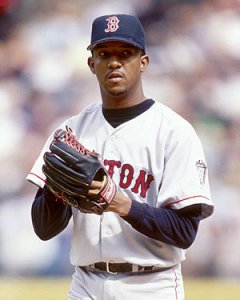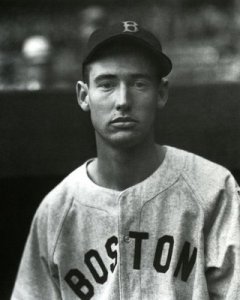(Note: This article was published by the author on another Red Sox web site prior to the establishment of this site.)
Forty-three years ago, the nation was entranced by the battle being waged between Mickey Mantle and Roger Maris, two Yankee greats who spent a summer trying to reach a baseball milestone: 61 home runs. This number would be one better than Babe Ruth‘s record, one that had been preserved for 34 years. Maris eventually reached this plateau, but his record was noted with an asterisk because he had played a 162-game season, unlike Ruth who had played in a 152-game one.
Thirty-seven years later, Mark McGwire and Sammy Sosa were credited with bringing life back into baseball when they went toe-to-toe to try and break this mark. McGwire reached the 62 home run mark in early September and, before the season ended, he had an amazing 70 round-trippers. But we remember also that, late in the season, McGwire admitted that he had been taking performance-enhancing drugs to help create those arms that looked as big as tree trunks. Eventually, the controversy was swept under the carpet and the focus turned to seeing if another could top that.
Only three years passed before we had an answer. After reaching the 500 career home run mark early in the season, Barry Bonds, the son of former player Bobby Bonds and godson of baseball legend “Say Hey” Willie Mays went on a tear and clobbered an amazing 73 home runs that season. To those who watched, his swing seemed almost effortless and the ball would sail well into upper decks and the far reaches of the stands. Before beginning his home run trot, Bonds would stay at the plate and admire the flight of the ball for a few seconds as if he were as astonished as the fans were of the power he possessed in those muscular cannons.
Now, mere weeks away from the opening of the 2004 baseball campaign, the suspicions of many have been made truth: that players, under invisible pressure in an effort to draw the crowds, have been taking steroids and other drugs to enhance their bodies and become modern-day Goliaths. This after random drug tests conducted last year confirmed that as many as five percent of those tested were juiced and after testimony in a legal case accused several baseball All-Stars of being supplied with steroids. One of those named was, sadly, Barry Bonds.
So where do we go from here? Has the game of baseball been ruined? Will the MLB suddenly find itself swept under the rug as has the XFL and the WUSA? The good news is that the baseball season has NOT been canceled at this point and that the Boston Red Sox have yet another chance to end the championship drought by season’s end, unless the New York Yankees again have the last say.
Yet perhaps this is another answer to bringing back a level playing field to the game of baseball besides the financial arguments. With the chance of being suspended from baseball either for weeks, months, or even years, perhaps some of those players will see the risk and decided that it isn’t worth it. It will also give more athletes who have played by the rules a better chance to become major-league ballplayers someday. Then, the competition will return to the field instead of being away from it; it will depend less on drugs and dangerous supplements and focus more on a natural strength and conditioning routine.
Granted, the healing process will be long and painful for baseball. There are probably many fans that, along with other reasons that have been given, will throw in the towel and no longer financially support a “tainted” game. Even those who stay, if they have not already been, will become more suspicious of a player’s ability when he steps up to the plate and jacks one into the seats. Parents may wonder further whether these athletes are good role models for the children who mimic the behavior and style of play of the professional players in the field and at the plate. Above all, the trust in these players, who have continued to proclaim their innocence, may soon be lost, whether they are guilty or not.
The players, and the game itself, must move on and shed this image as quickly as possible and bring an honest, open game back to the fans. Lessons from this must be learned and never forgotten. Several years after Maris broke the home run record, the asterisk was removed and he was given due respect for his accomplishment. Following these revelations, baseball will wear an asterisk from now until the wounds heal and the scars fade.

